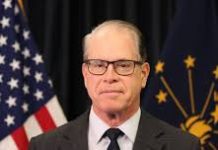By Erica IrishÂ
TheStatehouseFile.comÂ
INDIANAPOLIS — New findings by the Indiana Chamber of Commerce show Indiana is lagging behind other Midwestern states and several national competitors in areas important to the economy and local business.
Indiana stands to improve in three areas, according to the Chamber’s “Indiana Vision 2025: 2020 Snapshot†report. While the state ranks second of five Midwestern states for metrics that contribute to an “attractive business climate,†mostly for its tax and regulatory policies, Indiana’s workforce falls behind national competitors — at fourth place out of six states, including Iowa, Minnesota, North Carolina, Tennessee, and Utah — because of ongoing health concerns like smoking, obesity and drug deaths.
The Chamber report also identified lags in Indiana infrastructure and educational attainment that are causing harm to a business. The report called rising electricity prices a threat to Indiana’s large manufacturing industry, for example, and noted the state continues to train others in areas like entrepreneurship. Indiana is 44th in the nation for new entrepreneurs and 47th for employment at firms less than five years old, one indicator of entrepreneurship through startups.
“Even though Indiana has made a lot of progress over the last 20 years, there’s still a lot of work that needs to be done,†said Adam Berry, vice president of economic development and technology for the Indiana Chamber. “And other states aren’t slowing down.â€

Indiana is 33rd in the nation for the percent of the state population with less than a high school diploma, per a 2018 comparison that showed 10.2% of Hoosiers lack one. That’s just below the 2018 national average of 10.7%, according to information from the U.S. Census Bureau.
But the state also falls behind in terms of needed talent, including employees with bachelor’s degrees in high-demand fields like science and engineering. Indiana ranked 40th in the nation in this area in 2018, when around 12.4% of Hoosiers held a degree in the target fields. Midwestern neighbors Illinois, Michigan, and Ohio all outpaced Indiana in this area in 2018.
That’s despite gains in almost all of the state’s 12 Department of Workforce Development regions that indicate an improvement over the last year in the number of citizens with a degree, Berry said. The state is also behind in terms of new businesses formed in Indiana by entrepreneurs.
The COVID-19 pandemic places an added strain on Indiana business, too, making infrastructure concerns a priority to resolve issues with internet and broadband access to support increases in remote work and e-learning.
Before the Indiana Chamber released Thursday’s report, leaders with the Indiana Economic Development Corporation, a public-private partnership that also studies state business and administers grants, announced a new program to target challenges to Indiana business that have resulted from COVID-19. The $10 million initiative, called Economic Activity Stabilization and Enhancement or EASE, will award various grants to support manufacturing companies that choose to integrate smart technology and entrepreneurs who wish to start their own businesses.
Indiana Gov. Eric Holcomb has touted the state’s Next Level Jobs career training program at several virtual press briefings since the start of the COVID-19 pandemic as an option for unemployed Hoosiers to reenter the workforce, and hopefully with better, more stable jobs and careers.
An additional 23,604 Hoosiers had filed claims for unemployment benefits in the week ending June 6, according to the latest report from the U.S. Department of Labor. While the number of new claims has slowed since unemployment peaked in April, Indiana saw a large increase in claims from gig economy workers and independent contractors who can now receive unemployment benefits for the first time through the Pandemic Unemployment Assistance program.
Since the pandemic began about 12 weeks ago, an estimated 43 million Americans have filed for initial unemployment claims.
Both Berry and Kevin Brinegar, Indiana Chamber president, and CEO, praised the state for new efforts to emphasize workforce development but noted more can be done by the state legislature and others to support Hoosiers looking for a new career or the opportunity to start their own business.
“Indiana legislators have abdicated their responsibilities to students and parents by taking the state backward in abandoning accountability and failing to maintain a leading-edge approach,†Brinegar said in a statement.
Berry, for example, said the Chamber would like to see the General Assembly work more closely with school accountability and on consolidating school districts throughout the state. He also said there need to be more safeguards in place to encourage entrepreneurs to move forward with a business plan — a process often steeped in risk and uncertainty.
“We have to take steps to mitigate risks,†Berry said. “If they do fail — which the majority of businesses do — we need to make sure they don’t go bankrupt, or that their investors are discouraged from investing in more startups.â€
FOOTNOTE” Erica Irish is the 2020 Russell Pulliam editor for TheStatehouseFile.com, a news website powered by Franklin College journalism students.Â





